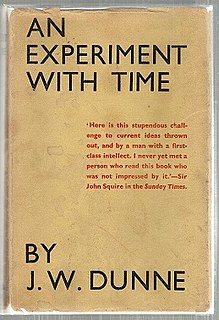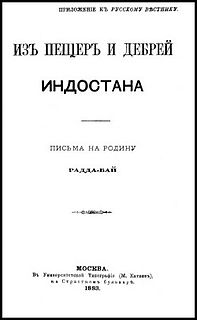 W
WChildren's Past Lives: How Past Life Memories Affect Your Child is a 1997 book by Carol Bowman. It is a non-academic book exploring the putative phenomenon of children's spontaneous past life memories.
 W
WAn Experiment with Time is a book by the British soldier, aeronautical engineer and philosopher J. W. Dunne about his precognitive dreams and a theory of time which he later called "Serialism". First published in March 1927, the book was widely read. Although never accepted by mainstream science, it has influenced imaginative literature ever since. Dunne published four sequels: The Serial Universe, The New Immortality, Nothing Dies and Intrusions?
 W
WExtrasensory Perception is a 1934 book written by parapsychologist Joseph Banks Rhine, which discusses his research work at Duke University. Extrasensory perception is the ability to acquire information shielded from the senses, and the book was "of such a scope and of such promise as to revolutionize psychical research and to make its title literally a household phrase".
 W
WFrom the Caves and Jungles of Hindostan: Letters to the Homeland is a literary work by the founder of the Theosophical Society Helena Blavatsky. She published it under the pen name Radda Bai in serial installments (letters) from 1879 to 1886 in Moscow in the periodicals Moskovskiya Vedomosti and Russkiy Vestnik, edited by Mikhail Katkov. The first part of these letters was published in a single volume in 1883 as an appendix to the journal Russkiy Vestnik. The second part of the letters was published in 1884–1886. The series obviously was never finished as it broke off rather suddenly.
 W
WIncidents in the Life of Madame Blavatsky: compiled from information supplied by her relatives and friends is a book originally published in 1886 in London; it was compiled by a member of the Theosophical Society A. P. Sinnett, the first biographer of H. P. Blavatsky. He describes the many unusual incidents in her life, beginning from her childhood in Russia and asserts that she has been with "an early connection with the supernatural world;" he says about her short unlucky marriage and "decade of extensive global travels," about her period of learning in Tibet, and the "criticism she received about some of her 'phenomena' and practices."
 W
WIrreducible Mind: Toward a Psychology for the 21st Century is a 2007 parapsychological book by Edward Francis Kelly, Emily Williams Kelly, Adam Crabtree, Alan Gauld, Michael Grosso, and Bruce Greyson. It attempts to bridge contemporary cognitive psychology and mainstream neuroscience with "rogue phenomena", which the authors argue exist in near-death experiences, psychophysiological influence, automatism, memory, genius, and mystical states.
 W
WIsis Unveiled: A Master-Key to the Mysteries of Ancient and Modern Science and Theology, published in 1877, is a book of esoteric philosophy and Helena Petrovna Blavatsky's first major work and a key text in her Theosophical movement.
 W
WLife After Life is a 1975 book written by psychiatrist Raymond Moody. It is a report on a qualitative study in which Moody interviewed 150 people who had undergone near-death experiences (NDEs). The book presents the author's composite account of what it is like to die. On the basis of his collection of cases, Moody identified a common set of elements in NDEs: (a) an overwhelming feeling of peace and well-being, including freedom from pain. (b) the impression of being located outside one's physical body. (c) floating or drifting through darkness, sometimes described as a tunnel. (d) becoming aware of a golden light. (e) encountering and perhaps communicating with a "being of light". (f) having a rapid succession of visual images of one's past. (g) experiencing another world of much beauty.
 W
WLondon lore: the legends and traditions of the world's most vibrant city is a 2008 book about the folklore and history of London by Steve Roud. Another edition was published in 2010.
 W
WLost Continents: The Atlantis Theme in History, Science, and Literature is a study by L. Sprague de Camp that provides a detailed examination of theories and speculations on Atlantis and other lost lands, including the scientific arguments against their existence. It is one of his most popular works. It was written in 1948, and first published serially in the magazine Other Worlds Science Fiction in 1952-1953; portions also appeared as articles in Astounding Science Fiction, Galaxy Science Fiction, Natural History Magazine, and the Toronto Star. It was first published in book form by Gnome Press in 1954; an updated edition was published by Dover Publications in 1970. De Camp revised the work both for its first book publication and for the updated edition.
 W
WMan: Whence, How and Whither, A Record of Clairvoyant Investigation, published in 1913, is a theosophical book compiled by the second president of the Theosophical Society (TS) - Adyar, Annie Besant, and by a TS member, Charles W. Leadbeater. The book is a study on early times on planetary chains, beginnings of early root races, early civilizations and empires, and past lives of men.
 W
WOccult Chemistry: Investigations by Clairvoyant Magnification into the Structure of the Atoms of the Periodic Table and Some Compounds is a book written by Annie Besant and C.W. Leadbeater, who were all members of the Theosophical Society based in Adyar, India. Besant was at the time the President of the Society having succeeded Henry Olcott after his death in 1907.
 W
WThe Occult World is a book originally published in 1881 in London; it was compiled by a member of the Theosophical Society A. P. Sinnett. It was the first theosophical work by the author; according to Goodrick-Clarke, this book "gave sensational publicity to Blavatsky's phenomena" and the letters from the mahatmas, and drew the attention of the London Society for Psychical Research.
 W
WParapsychology: Frontier Science of the Mind is a book by Joseph Banks Rhine and Joseph Gaither Pratt, originally published in 1957. It is a textbook and reference work which provides an introduction to the field of parapsychology, which discusses "methods for testing, tables for evaluation, reading lists, and other research aids".
 W
WThe Psychology of the Occult is a 1952 skeptical book on the paranormal by psychologist D. H. Rawcliffe. It was later published as Illusions and Delusions of the Supernatural and the Occult (1959) and Occult and Supernatural Phenomena (1988) by Dover Publications. Biologist Julian Huxley wrote a foreword to the book.
 W
WThe Roots of Coincidence is a 1972 book by Arthur Koestler. It is an introduction to theories of parapsychology, including extrasensory perception and psychokinesis. Koestler postulates links between modern physics, their interaction with time and paranormal phenomena. It is influenced by Carl Jung's concept of synchronicity and the seriality of Paul Kammerer.
 W
WScience Friction: Where the Known Meets the Unknown is a 2004 book by Michael Shermer, a historian of science and founder of The Skeptics Society. It contains thirteen essays about "personal barriers and biases that plague and propel science, especially when scientists push against the unknown. What do we know, and what do we not know?" These include an essay relating the author's experience of a day spent learning cold reading techniques well enough to be accepted as a psychic. As well as covering skepticism and pseudoscience, Shermer discusses other topics touching on the subject of encouraging scientific thought, such as sport psychology and the writings of Stephen Jay Gould.
 W
WSpectropia, or, surprising spectral illusions showing ghosts everywhere and of any colour is an optical illusion book by J. H. Brown, first published in 1864.
 W
WWhy People Believe Weird Things: Pseudoscience, Superstition, and Other Confusions of Our Time is a 1997 book by science writer Michael Shermer. The foreword was written by Stephen Jay Gould.